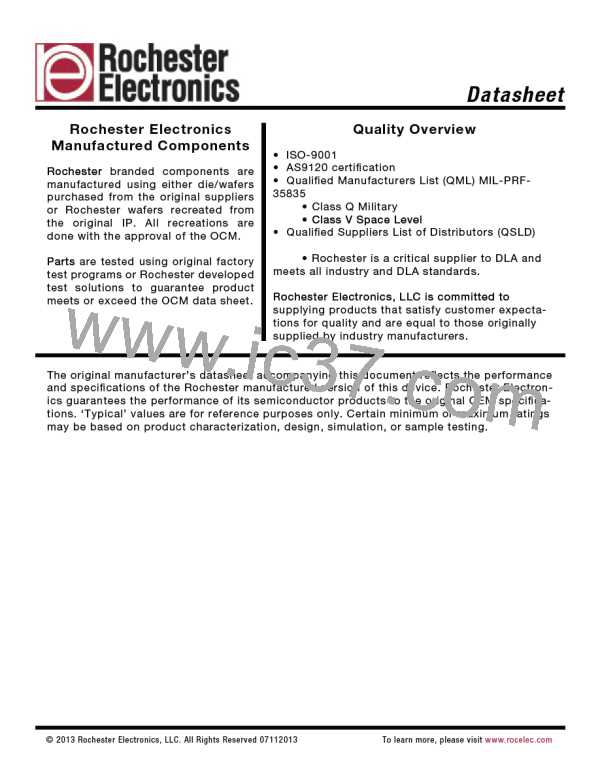OP777/OP727/OP747
1.5
1.0
14.964
ꢂ14.930
ꢂ14.935
ꢂ14.940
ꢂ14.945
V
I
= ꢁ15V
= 1mA
V
= ꢁ15V
= 1mA
SY
SY
V
V
= ꢁ15V
= 0V
= 25ꢄC
SY
14.962
I
L
L
CM
14.960
T
A
14.958
14.956
14.954
0.5
0
14.952
14.950
14.948
ꢂ0.5
ꢂ1.0
ꢂ1.5
ꢂ14.950
ꢂ14.955
ꢂ14.960
14.946
14.944
ꢂ40 ꢂ20
ꢂ40 ꢂ20
0
0
0
ꢂ60
20 40 60 80 100 120 140
0.5 1.0 1.5 2.0 2.5 3.0 3.5 4.0 4.5 5.0
ꢂ60
20 40 60 80 100 120 140
TIME – Minutes
TEMPERATURE – ꢄC
TEMPERATURE – ꢄC
TPC 46. Output Voltage High vs.
Temperature
TPC 48. Warm-Up Drift
TPC 47. Output Voltage Low vs.
Temperature
BASIC OPERATION
The OP777/OP727/OP747 amplifier uses a precision Bipolar
PNP input stage coupled with a high-voltage CMOS output
stage. This enables this amplifier to feature an input voltage
range which includes the negative supply voltage (often ground-
in single-supply applications) and also swing to within 1 mV of the
output rails. Additionally, the input voltage range extends to within
1 V of the positive supply rail. The epitaxial PNP input structure
provides high breakdown voltage, high gain, and an input bias cur-
rent figure comparable to that obtained with a “Darlington” input
stage amplifier but without the drawbacks (i.e., severe penalties for
input voltage range, offset, drift and noise). The PNP input structure
also greatly lowers the noise and reduces the dc input error terms.
V
OUT
0V
V
IN
TIME – 0.2ms/DIV
Supply Voltage
Figure 1. Input and Output Signals with VCM < 0 V
The amplifiers are fully specified with a single 5 V supply and, due
to design and process innovations, can also operate with a supply
voltage from 2.7 V up to 30 V. This allows operation from most
split supplies used in current industry practice, with the advantage
of substantially increased input and output voltage ranges over
conventional split-supply amplifiers. The OP777/OP727/OP747
series is specified with (VSY = 5 V, V– = 0 V and VCM = 2.5 V
which is most suitable for single-supply application. With PSRR of
130 dB (0.3 µV/V) and CMRR of 110 dB (3 µV/V) offset is mini-
mally affected by power supply or common-mode voltages. Dual
supply, 15 V operation is also fully specified.
100kꢇ
100kꢇ
+3V
ꢂ0.27V
100kꢇ
OP777/
OP727/
OP747
100kꢇ
ꢂ0.1V
V
= 1kHz at 400mV p-p
IN
Input Common-Mode Voltage Range
Figure 2. OP777/OP727/OP747 Configured as a Differ-
ence Amplifier Operating at VCM < 0 V
The OP777/OP727/OP747 is rated with an input common-mode
voltage which extends from the minus supply to within 1 V of the
positive supply. However, the amplifier can still operate with input
voltages slightly below VEE. In Figure 2, OP777/OP727/OP747 is
configured as a difference amplifier with a single supply of 2.7 V
and negative dc common-mode voltages applied at the inputs
terminals. A 400 mV p-p input is then applied to the noninverting
input. It can be seen from the graph below that the output does not
show any distortion. Micropower operation is maintained by using
large input and feedback resistors.
–10–
REV. C

 ROCHESTER [ Rochester Electronics ]
ROCHESTER [ Rochester Electronics ]